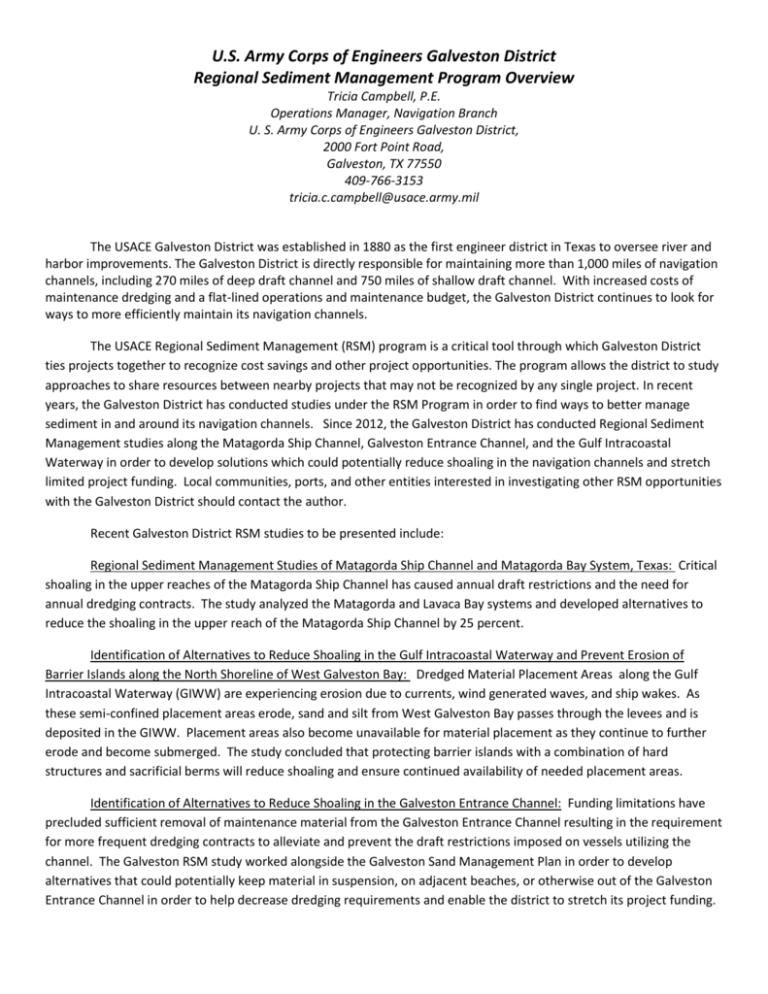U.S. Army Corps of Engineers Galveston District Regional
advertisement

U.S. Army Corps of Engineers Galveston District Regional Sediment Management Program Overview Tricia Campbell, P.E. Operations Manager, Navigation Branch U. S. Army Corps of Engineers Galveston District, 2000 Fort Point Road, Galveston, TX 77550 409-766-3153 tricia.c.campbell@usace.army.mil The USACE Galveston District was established in 1880 as the first engineer district in Texas to oversee river and harbor improvements. The Galveston District is directly responsible for maintaining more than 1,000 miles of navigation channels, including 270 miles of deep draft channel and 750 miles of shallow draft channel. With increased costs of maintenance dredging and a flat-lined operations and maintenance budget, the Galveston District continues to look for ways to more efficiently maintain its navigation channels. The USACE Regional Sediment Management (RSM) program is a critical tool through which Galveston District ties projects together to recognize cost savings and other project opportunities. The program allows the district to study approaches to share resources between nearby projects that may not be recognized by any single project. In recent years, the Galveston District has conducted studies under the RSM Program in order to find ways to better manage sediment in and around its navigation channels. Since 2012, the Galveston District has conducted Regional Sediment Management studies along the Matagorda Ship Channel, Galveston Entrance Channel, and the Gulf Intracoastal Waterway in order to develop solutions which could potentially reduce shoaling in the navigation channels and stretch limited project funding. Local communities, ports, and other entities interested in investigating other RSM opportunities with the Galveston District should contact the author. Recent Galveston District RSM studies to be presented include: Regional Sediment Management Studies of Matagorda Ship Channel and Matagorda Bay System, Texas: Critical shoaling in the upper reaches of the Matagorda Ship Channel has caused annual draft restrictions and the need for annual dredging contracts. The study analyzed the Matagorda and Lavaca Bay systems and developed alternatives to reduce the shoaling in the upper reach of the Matagorda Ship Channel by 25 percent. Identification of Alternatives to Reduce Shoaling in the Gulf Intracoastal Waterway and Prevent Erosion of Barrier Islands along the North Shoreline of West Galveston Bay: Dredged Material Placement Areas along the Gulf Intracoastal Waterway (GIWW) are experiencing erosion due to currents, wind generated waves, and ship wakes. As these semi-confined placement areas erode, sand and silt from West Galveston Bay passes through the levees and is deposited in the GIWW. Placement areas also become unavailable for material placement as they continue to further erode and become submerged. The study concluded that protecting barrier islands with a combination of hard structures and sacrificial berms will reduce shoaling and ensure continued availability of needed placement areas. Identification of Alternatives to Reduce Shoaling in the Galveston Entrance Channel: Funding limitations have precluded sufficient removal of maintenance material from the Galveston Entrance Channel resulting in the requirement for more frequent dredging contracts to alleviate and prevent the draft restrictions imposed on vessels utilizing the channel. The Galveston RSM study worked alongside the Galveston Sand Management Plan in order to develop alternatives that could potentially keep material in suspension, on adjacent beaches, or otherwise out of the Galveston Entrance Channel in order to help decrease dredging requirements and enable the district to stretch its project funding. Identification of Alternatives to Reduce Shoaling in the Lower Matagorda Ship Channel (ongoing study): Shoaling in the lower Matagorda Ship Channel (MSC) between the inlet and intersection of the GIWW and MSC has led to draft restrictions in recent years. Analysis of physical conditions and alternative dredging practices is needed to develop potential approaches that could be applied to increase channel availability. This project will finalize and integrate previous studies in Matagorda Bay to provide a common picture of physical processes and historical data for Operations Managers and other users to help improve the decision making process. This project will develop a common picture of the region, Web maps, tools, and databases which will support ongoing and future studies and channel maintenance operations.








